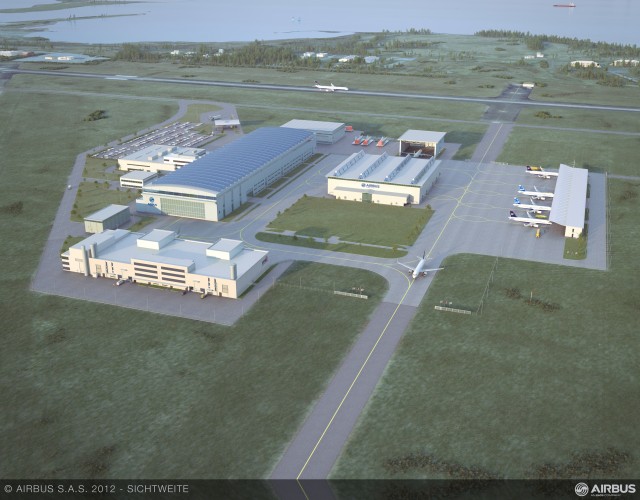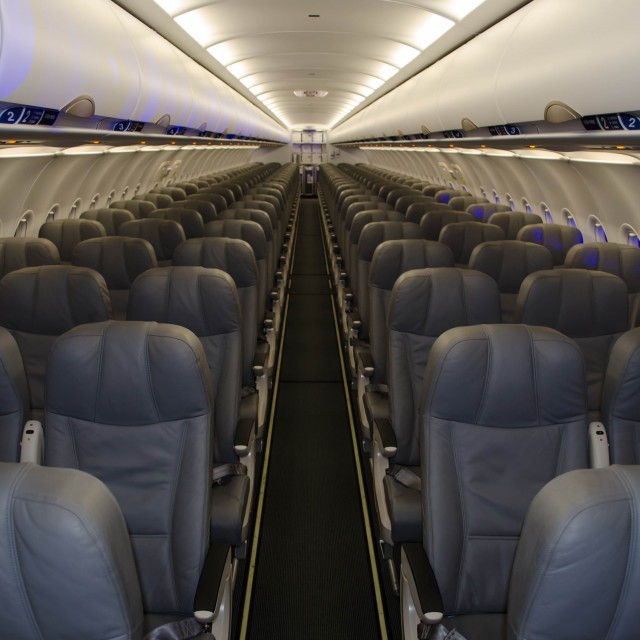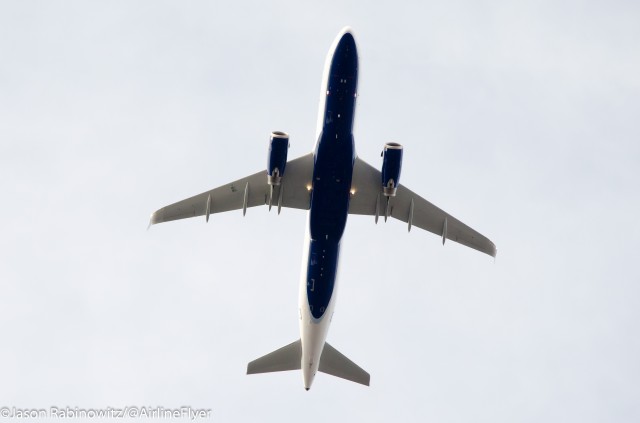Browsing Tag: Airbus A320
Today I pay my respects to a little-known (now defunct) Ukrainian airline by honoring their wild livery and individualism. Donbassaero’s bold, in-your-face paint scheme oddly reminds me of something you might see on a 1970s muscle car like the Oldsmobile 442.
This livery and airline is extra special. You see, while the rest of the world’s airlines were trending towards boring, mostly white (read: cheap) liveries referred to as “Eurowhite,” Donbassaero did the opposite.

HI-RES : Click for larger. Airbus’ first U.S.-based production facility ’“ which will build A320 Family jetliners at the Brookley Aeroplex in Mobile, Alabama, beginning in 2015 ’“ will produce between 40 and 50 aircraft annually by 2018.
Last Monday Airbus took its first step towards being an around the clock aircraft maker as it broke ground on its new Mobile, Alabama A320 plant.
When we say around the clock we literally mean it, with the new Mobile factory this will be the 4thA320 factory in the world with others in China, Germany and the company’s headquarters in Toulouse France. When the A320’s begin to be built in this factory the sun will never set on the baby bus.
At the ceremony, Airbus President and CEO Fabrice Brgier acknowledged how important and significant it is for the company to open a facility in the US, ’œBuilding an A320 family assembly line in Mobile is truly groundbreaking for Airbus. Our customers need more aircraft that cut fuel burn, emissions and operating costs. With this assembly line we will be able to meet our customers’ need at their doorstep, in addition to the worldwide demand for these efficient aircraft. When the line opens, we will be the only maker to assemble aircraft in Asia, Americas and Europe.’

The ceremonial groundbreaking for Airbus’ U.S. A320 Family final assembly line ’“ which occurred 8 April 2013 in Mobile, Alabama ’“ was marked by Airbus President and CEO Fabrice Brgier (fourth from right) and EADS CEO Tom Enders (sixth from right), along with state and national dignitaries, industry leaders and members of the local community. Photo from Airbus.
The new line will be located at the Mobile Brookley Aeroplex and will be able to assemble the entire A320 family: the A319, A320 and A321. The airline to receive the first US built A320 will be JetBlue. “We’re excited to welcome our long-term partners at Airbus to the United States and we look forward to taking delivery of the first U.S.-produced Airbus in 2016,” JetBlue spokesperson Mateo LLeras explained to AirlineReporter.com.
BONUS: Check out the Airbus mini-site dedicated to the new Mobile location
Major construction is set to begin this summer and be complete by late 2015 with the first aircraft set to be delivered in early 2016. Once they get the dust settled and Airbus hopes that the assembly line will produce four aircraft per month. The manufacture plans to deliver aircraft from Mobile to North and South America airline customers.
So why is Airbus making this move? Well you have to go back to 2005 when Boeing was originally awarded the US Air Force (AF) Tanker contract. There were too many question surrounding fraud, that the Air Force was required to re-bid. Airbus wanted in on the contract and to make their bid serious, the aircraft maker purchased land in Mobile that it intended to open an A330 tanker factory if they won. In 2008 Airbus was awarded the contract to build the A330 Multi Role Tanker (MRT), so they went through with the purchase the land.
After an appeal by Boeing, the Air Force decided to re-bid for a third time where Boeing won with their 767MRT. But now Airbus had all of this land and once they learned that they lost the contract Airbus announced that it still intended to bring a couple thousand jobs to the Mobile area and create an A320 plant instead of trying to sell the land.
One question that we are all curious about at AirlineReporter.com is that by having this factory in the US now can Airbus sway major US Boeing customers to come its way such as Southwest Airlines, United Airlines or Delta Air Lines who have do already (with an exception to Southwest) have Airbuses in its fleet but only cause they acquired them through mergers with other US major airlines, not from its own purchases.
Also there is potential for Airbus to acquire more land in Mobile, could we see a second line down the road or another type come to the US all together? This could get interesting.
SEE MORE MOBILE ALABAMA AIRBUS GROUND BREAKING PHOTOS
 |
This story written by…Brandon Farris, Correspondent. Brandon is an avid aviation geek based in Seattle. He got started in Photography and Reporting back in 2010. He loves to travel where ever he has to to cover the story and try to get the best darn shot possible.@BrandonsBlog | RightStuffPhotography | Flickr |
How does an airline burn less fuel, and make their aircraft look cooler in the process? The answer is simple: Winglets. Actually, in this case, sharklets. In late 2012, Airbus finally delivered their first A320 with blended winglets to AirAsia, which they have affectionately named a sharklet. Sharklets promise a reduced fuel burn of up to 3.5 percent, which leads to less CO2 emissions and greater profits air airlines.
New York based JetBlue is the first North American airline to sport sharklets, and is also the first airline worldwide to retrofit a production A320 with sharklets. The retrofit was completed by in-house technicians at the airlines John F. Kennedy Airport maintenance hanger. At an event Wednesday, JetBlue and Airbus were proud to show it off.
“I’m excited,” said Mark Powers, JetBlue Chief Financial Officer. “But I’m not excited that when the plane flies to San Francisco, its going to save us $568.75. No, no, I’m not excited about that. Nor am I excited about the fact that this airplane will save, conservatively, $350,000 a year. Nah, that doesn’t excite me either. And actually, once the whole fleet is retro fitted, were going to save $45 million a year, but that doesn’t excite me either. What really excites me, this airplane looks really cool. Winglets complete this aircraft.”
The first retrofit was completed quicker than expected, returning the aircraft to revenue service early. JetBlue plans to retrofit several A320s this year, but the entire fleet is not expected to be converted for several years. Older airframes will takes up to three weeks to be retrofitted, due to the wings requiring strengthening. Newer airframes will only require a few days to complete the process. All new A320 and A321 deliveries will include sharklets.
UPDATE: First Flight
Although no test flight was announced, N821JB did indeed take to the skies on Friday for a test flight. Here are some pictures at it departs JFK over my house.
 |
This story written by… Jason Rabinowitz, Correspondent.Jason is a New York City native who has grown up in the shadow of JFK International Airport. A true “avgeek”, he enjoys plane spotting and photography, as well taking any opportunity he can get to fly on an aircraft.@AirlineFyer | FaceBook | |

An American Airlines 757-200 at Los Angeles, a sight that can’t last forever – Photo: Mal Muir / AirlineReporter.com
If you fly long-haul in North America you have probably flown on a narrow bodied aircraft. Whether it be transcontinental flights between the coasts or flying transatlantic between the USA and Europe, the North American airlines just love to use these smaller, more efficient aircraft. For me, the daddy of these aircraft is the Boeing 757, which is no longer in production but still is the stalwart of the narrow bodies.
Flying with Delta, United, US Airways and American Airlines you will more than likely step onto a 757-200 or the super long 757-300 for a flight to Hawaii, New York or even London. But what happens when this aircraft goes out of service? What is there to replace it? As the 757s start to be retired from service due to age (US Airways is already doing this), the airlines are going to have to start replacing these aircraft with something… but what?

A Rough Chart showing Etops 60 vs Etops 120 between New York and London
You need to look first at what makes these aircraft so popular: the passenger to range ratio. The 757 has that unique mix of enough passengers on-board with the range to get it over an ocean or across a large continent without a hassle, while still maintaining reasonable fuel burn costs. The narrow body set up (single aisle) allows the flight to serve routes, and especially cities, which would not be able to handle the wide body (generally double aisle) aircraft such as the Boeing 767, Boeing 777 or Airbus A330.
Historically if you were going to fly long-haul you needed four engines. Even as far back as the Boeing 707 or the Douglas DC 8, these aircraft were designed to fly those long haul routes with engines for backup, should one fail. Then along came aircraft like the Boeing 757, 767 and Airbus A300. They only had two engines, but were still able to cover long distances over water with only minor changes.
Although ETOPS (Extended Range Twin Engine Operations) has been around for quite some time it had always been restricted 60 minutes, then it was extended to 120 minutes. The 120 extension came in to help flights across the Atlantic to London.
At a 60 minute rating they would have to fly from New York to London over Iceland to ensure that there was a landing site in range within 60 minutes. With new engine & navigation technology, came the introduction of 120 rating (though 180 minute etops is now the standard). It meant you could go direct over the ocean without a worry, as half way across you would still be within 2 hours of Iceland or New York or London. This revolutionized air travel.
As technology progressed more, the ETOPS ratings extended out, with Boeing currently holding a 330 minute rating for the 777 & 787 aircraft. Airbus is expecting a 350 minute rating for the new A350 XWB.
Today, narrow body aircraft serve plenty of ETOPS routes. Alaska Airlines operates the Boeing 737-800 & 900 from the west coast to Hawaii and there are quite a few rumors that Southwest might join them with their 737-800’s as well.
The A320 family though does some interesting ETOPS flights as well. The Airbus A318, also known as the Baby Bus, flies across the Atlantic with British Airways and Air Canada Air Canada flies an A319; a long way to go on such a small aircraft. When you have long thin routes (long distance, small amount of passengers) you need to use an appropriate aircraft.
But which aircraft will most likely fill the gap that the 757 will leave? Boeing has the 737-900ER and variants of the new 737 Max as well. Airbus is offering the A321 and soon the A321neo.
The A320neo family should extend the range of this aircraft by a good 600 miles. This could be the difference of serving a route or not and combines the capacity of the original A321, with the range of an A319 (the aircraft in the Airbus narrow body family with the longest range).
American Airlines has selected the A321 to replace its aging 757-200s and 767-200s on its transcontinental routes. Hawaiian Airlines just ordered the A321neo to expand its ETOPS operations. Flights from Honolulu to Los Angeles for instance are in the range of an A321neo and by utilizing this aircraft, they can free up some of their A330s or 767s to serve other, longer routes or routes that need the higher capacity. The A321neo will allow them to expand to possible new markets that do not have the demand for the larger A330 or 767.
Other airlines, like Icelandair, which currently only operates a fleet of Boeing 757s, are planning to expand their operations by introducing 12 737 MAX 8 and 9 aircraft. United Airlines, which currently has over 150 757s has ordered 100 737 MAX aircraft, which many will be used to replace the aging 757s.

Mock up of what Hawaiian Airlines Airbus A321NEO will look like. Aircraft image from Airbus, edited by Brandon Farris.
The new Airbus A321neo and 737 9 MAX will change the narrow body long range family, as it takes over those routes the 757 currently serves. This will also put more 757s on the market and possibly low cost carriers like Allegiant Air, might be able to add more 757s to their fleet and expand their ETOPs flights.
These aircraft and other new ones like it should replace those venerable 757s flying the sky at the moment. It will be good for those flying on-board, as new aircraft means a better on-board experience, but for some like me, it will be a sad day to see fewer 757s take flight. Seeing that ungainly long body of the 757-300, which looks like it shouldn’t exist on such a thin aircraft, is an amazing sight. When you step on-board, the single aisle looks like it will never end. Hopefully these new aircraft can inspire similar thoughts amongst future generations of AvGeeks.
 |
This story written by…Malcolm Muir, Lead Correspondent. Mal is an Australian Avgeek now living and working in Seattle. With a passion for aircraft photography, traveling and the fun that combining the two can bring. Insights into the aviation world with a bit of a perspective thanks to working in the travel industry.@BigMalX | BigMal’s World | Photos |





















